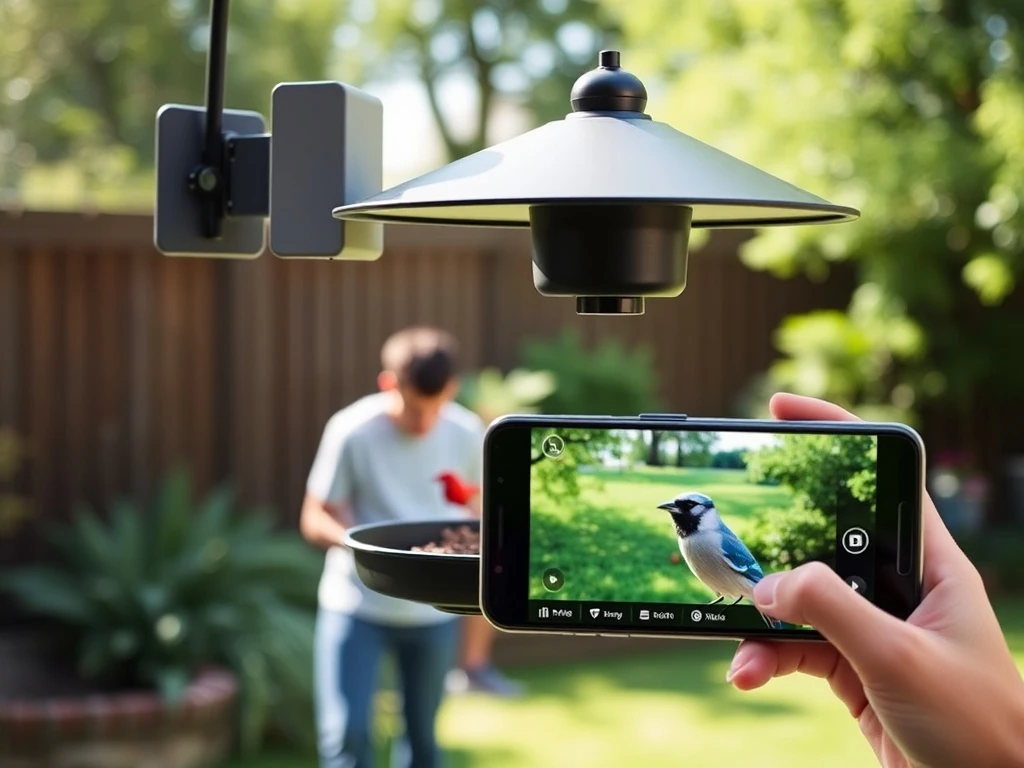Backyard birdwatching has long been a cherished pastime, offering a peaceful escape and a profound connection to the natural world. Imagine observing a vibrant cardinal, a curious chickadee, or a graceful hummingbird right from your living room, without disturbing their natural behavior. Now, thanks to rapid advancements in smart home technology, this experience is being transformed. Enter the world of smart bird feeders – devices that are redefining how we interact with and learn about our feathered friends. These high-tech feeders combine artificial intelligence, high-definition video, and seamless app connectivity, creating an unparalleled window into the avian world. Whether you’re a seasoned birder with years of experience or just beginning your journey into nature observation, smart bird feeders offer an exciting, convenient, and deeply insightful way to engage with wildlife.
What Exactly Are Smart Bird Feeders?
At its core, a smart bird feeder is a modern twist on a classic backyard staple. It’s a next-generation bird feeder equipped with advanced features that elevate it far beyond a simple food dispenser. Think of it as a personal wildlife camera, data collector, and identification expert, all rolled into one weather-resistant package. Unlike traditional feeders that rely solely on your presence and manual observation, smart bird feeders provide an ‘always-on’ birdwatching experience. They automatically capture moments, identify species, and send notifications, making them ideal for busy individuals, tech enthusiasts, and anyone eager to learn more about the birds visiting their yard.
The key components that make these feeders ‘smart’ include:
- Motion-Activated HD Cameras: These cameras record crisp, clear video and photos, often with wide-angle lenses to capture more of the action. Many also include night vision capabilities, extending your birdwatching into the dusk and dawn hours.
- Artificial Intelligence (AI) Species Recognition: This is perhaps the most groundbreaking feature. Built-in AI models are trained on vast datasets of bird images and sounds, allowing the feeder to automatically identify the species of bird visiting. No more guessing games!
- Wireless Connectivity and Mobile Apps: Via Wi-Fi, the feeder connects to a dedicated mobile app on your smartphone or tablet. This app is your command center, providing real-time alerts, live feeds, recorded footage, and access to identification logs.
- Cloud Storage: Most smart bird feeders offer cloud storage options, allowing you to save and review your bird sightings without filling up your device’s memory. This is crucial for tracking long-term trends and building a personal birding archive.
The Unrivaled Features of Smart Bird Feeders
The market for smart bird feeders is expanding, with new models continually introducing innovative features. While specific offerings vary by brand, most high-end smart feeders come packed with a powerful suite of functionalities designed to enhance your birdwatching journey:
- Crystal-Clear HD Video & Photo Capture: From 1080p to 4K resolution, these cameras ensure every feather and subtle movement is captured with stunning clarity. Integrated night vision means your observation doesn’t stop when the sun goes down, revealing nocturnal visitors or early risers.
- Precision AI Bird Identification: The AI isn’t just a gimmick; it’s a sophisticated tool. It can identify thousands of bird species with impressive accuracy, often providing details like common name, scientific name, and even brief facts about the bird directly in the app.
- Instant Mobile App Alerts & Live Streaming: Receive push notifications the moment a bird lands on your feeder. With a tap, you can view a live feed, watching the bird in real time from anywhere in the world, as long as you have an internet connection.
- Secure Cloud Storage & Data Management: Your captured photos and videos are securely stored in the cloud, often with options for tiered storage plans. This allows for easy review, categorization, and sharing of your favorite sightings. Many apps also compile statistics on visits, species frequency, and peak activity times.
- Intelligent Squirrel Detection & Deterrence: A common frustration for birdwatchers is dealing with squirrels. Many smart bird feeders incorporate AI to distinguish between birds and other animals. Some even include gentle deterrents like a small vibration or a sound alarm to discourage squirrels without harming them.
- Robust Weather-Resistant Construction: Designed for the outdoors, these feeders are built to withstand various weather conditions, from heavy rain and snow to intense sunlight, ensuring year-round operation.
- Sustainable Solar Charging Options: A growing number of models now include integrated solar panels, providing continuous power and reducing the need for frequent battery recharges. This makes them more eco-friendly and convenient for off-grid placement.
- Two-Way Audio (on some models): A more advanced feature found on some premium feeders allows you to hear the birds chirping and even speak through a small speaker, though this is primarily for novelty or specific research purposes.
Why Are Smart Bird Feeders Captivating Birdwatchers, From Beginners to Pros?
The appeal of smart bird feeders spans the entire spectrum of birdwatching enthusiasts, offering distinct advantages for everyone:
For the Casual Birdwatcher: Effortless Discovery and Connection
If you’re new to birdwatching or simply enjoy the occasional backyard visitor, smart feeders remove all the guesswork and effort. You no longer need a field guide constantly by your side. The app instantly tells you which bird just landed, often with fascinating facts. This automatic identification fosters rapid learning and deeper appreciation. Furthermore, these feeders capture every visit, even when you’re at work, on vacation, or simply busy indoors. You won’t miss a moment. The engaging visuals and easy sharing features make it a fantastic, educational activity for families, sparking curiosity in children and adults alike.
For the Dedicated Birder and Researcher: Unprecedented Data and Insights
For those with a serious passion for ornithology or citizen science, smart bird feeders are a game-changer. They provide:
- Long-Term Tracking: Automatically timestamped and visually recorded visits create a robust database of avian activity in your yard.
- Reliable Data Collection: This consistent data is invaluable for observing seasonal trends, understanding migration patterns, and monitoring local bird populations. It moves beyond anecdotal observation to quantifiable insights.
- Citizen Science Integration: Many smart feeder apps offer seamless integration with platforms like Cornell Lab of Ornithology’s Merlin Bird ID or eBird, allowing you to contribute your sightings to larger scientific databases, making a real impact on conservation efforts.
- Behavioral Studies: The continuous recording allows for detailed observation of feeding behaviors, inter-species interactions, and even nest-building activities, offering a unique window into avian ecology.
This powerful blend of convenience, accessibility, and robust data collection positions smart bird feeders as an indispensable tool for anyone with an interest in birds, local ecology, or contributing to scientific understanding.
The Brains Behind the Feeder: How AI Powers Smart Bird Feeders
One of the most remarkable and transformative aspects of smart bird feeders is their sophisticated use of artificial intelligence for bird identification. This isn’t just simple image matching; it involves advanced machine learning algorithms. Here’s a closer look at how it works:
- Training Data: AI models are trained on massive datasets comprising millions of bird images and videos, meticulously labeled by human experts. This data includes birds from various angles, lighting conditions, and stages of life (juvenile, adult, male, female).
- Feature Extraction: When a bird visits your feeder, the camera captures an image or video frame. The AI then processes this visual data, extracting key features like feather patterns, beak shape, body size, wing structure, and color distribution.
- Pattern Recognition: These extracted features are compared against the patterns learned during training. The AI identifies the closest matches from its vast knowledge base.
- Confidence Score: The system then assigns a confidence score to potential identifications. If the confidence is high enough, it provides an instant species ID. Some advanced systems can even distinguish between similar-looking species based on subtle differences.
- Continuous Learning: Many smart bird feeders and their associated apps use a form of continuous learning. As more users submit data and correct identifications, the AI models can be further refined and improved, leading to even greater accuracy over time.
This capability transforms your backyard into an active research station. You don’t need to be an expert ornithologist; the technology handles the complex identification, allowing you to focus on the joy of observation and the continuous learning that comes with every new visitor. It truly democratizes bird identification, making it accessible to everyone.
Beyond Observation: Engaging with Nature Through Smart Bird Feeders
Smart bird feeders do more than just record birds; they foster a deeper, more active engagement with the natural world around you. They bridge the gap between busy modern life and the tranquility of nature, allowing you to stay connected even when you can’t be physically present. Imagine:
- Receiving an alert and watching a live stream of a rare warbler at your feeder while you’re at work or on vacation.
- Building a comprehensive digital journal of all your backyard visitors, complete with photos, videos, and timestamps, creating a personal ecological record.
- Sharing captivating clips of a hummingbird hovering or a woodpecker at work directly to social media, inspiring friends and family.
- Using the feeder’s data to understand peak feeding times, favorite foods, and how different species interact, turning your backyard into a living laboratory.
For families, these feeders turn passive backyard observation into an interactive, educational adventure. Children can learn about different bird species, their habitats, and behaviors in a fun, visual way. It’s an accessible tool that encourages curiosity, fosters environmental awareness, and provides endless moments of wonder for all ages.
Navigating the Landscape: Considerations Before Investing in Smart Bird Feeders
While the benefits are clear, like any advanced technology, smart bird feeders come with a few considerations to keep in mind before making a purchase:
| Consideration | Details | Tip/Solution |
|---|---|---|
| Cost | Initial investment can range from $100 for basic models to $400+ for premium ones with advanced AI, solar, and large storage. | Set a budget. Entry-level models still offer great value. Look for sales. |
| Wi-Fi Dependence | Requires a strong, stable outdoor Wi-Fi signal for live streaming, alerts, and cloud uploads. Weak signals can lead to dropped connections or delayed notifications. | Check your outdoor Wi-Fi strength before buying. Consider a Wi-Fi extender or mesh system if needed. |
| Privacy Concerns | These devices have cameras. Be mindful of camera placement to avoid inadvertently capturing neighbors’ private spaces. | Position the feeder carefully, focusing on your own property and the feeder itself. Review privacy policies of the manufacturer. |
| App Usability & Subscriptions | Not all companion apps are equally user-friendly or reliable. Some features (like extended cloud storage or premium AI features) may require a monthly/annual subscription. | Read reviews about the app’s performance. Factor in potential subscription costs when comparing models. |
| Maintenance | Beyond refilling food, cameras need occasional cleaning for clear footage. Batteries (if not solar) need recharging. Data storage might need management. | Choose models with easy-to-access camera lenses and consider solar-powered options for less frequent battery management. |
Despite these points, the market for smart bird feeders is rapidly maturing. Manufacturers are actively addressing these concerns, with improved app interfaces, more robust connectivity, and increasingly affordable options becoming available. The overall user experience continues to improve dramatically.
The Future Takes Flight: What’s Next for Smart Bird Feeders?
The rapid adoption and continuous innovation in smart bird feeders signal a significant shift: wildlife observation is undeniably going digital. The trajectory of this technology suggests even more immersive and integrated experiences in the near future:
- Enhanced AI Capabilities: Expect AI to not only identify species but also recognize individual birds, track their specific behaviors (e.g., feeding patterns, mating rituals), and even detect signs of illness or distress.
- Community-Connected Networks: Imagine feeders that can share anonymized data with local birding communities or scientific researchers, creating vast, real-time networks for tracking bird populations and migration across regions.
- Augmented Reality (AR) Integration: Future apps might overlay AR elements onto live video feeds, displaying detailed facts about the bird you’re watching, historical data, or even simulated migration routes directly on your screen.
- Voice-Activated Alerts: Integration with smart home assistants could mean your smart speaker announces, ‘A Pileated Woodpecker has arrived at the feeder!’
- Advanced Deterrence & Monitoring: More sophisticated, humane deterrents for unwanted visitors, along with environmental sensors that monitor air quality, temperature, and even pollen levels, providing a holistic view of your backyard ecosystem.
- Gamification and Educational Tools: Apps could incorporate challenges, leaderboards (for most species identified), and interactive learning modules to make birdwatching even more engaging, especially for younger generations.
This wave of innovation is creating a more immersive, informative, and accessible birding experience for everyone, regardless of their location or prior expertise. It’s an exciting time to be a birdwatcher, with technology continuously opening new doors to the wonders of nature.
Making the Smart Choice: Tips for Selecting Your Ideal Smart Bird Feeder
Ready to upgrade your birdwatching experience? Choosing the right smart bird feeder depends on your specific needs, budget, and desired features. Here are some actionable tips to guide your selection:
- Assess Your Wi-Fi Coverage: Before anything else, check if you have a strong Wi-Fi signal where you plan to place the feeder. This is non-negotiable for real-time streaming and alerts.
- Prioritize Camera Quality: If clear identification and stunning visuals are important, look for HD (1080p or higher) cameras with good low-light performance and a wide field of view.
- Evaluate AI Accuracy: Read reviews specifically mentioning the accuracy of the AI bird identification. Some brands excel in this area more than others.
- Consider Power Options: Solar charging is highly convenient, reducing the need for frequent battery swaps. If choosing battery-powered, check battery life and ease of recharging.
- Check App Features & Subscriptions: Download the app (if possible) before buying to get a feel for its interface. Understand what features are free and which require a subscription.
- Read User Reviews: Real-world user experiences can provide invaluable insights into a feeder’s durability, connectivity, and overall performance.
- Squirrel Deterrence: If squirrels are a major issue in your yard, prioritize models with effective squirrel detection and humane deterrence mechanisms.
Whether you’re looking for a top-tier AI powerhouse or a budget-friendly camera setup to simply observe visitors, there’s a smart bird feeder out there that’s perfect for your backyard. It’s an investment in endless hours of natural wonder and a deeper connection to the vibrant ecosystem right outside your door.
Backyard birdwatching has transformed from a quiet, observational hobby into an interactive, data-rich experience, thanks to the advent of smart bird feeders. These technological marvels, equipped with HD cameras, advanced AI, and seamless app connectivity, offer an unparalleled window into the avian world. They empower casual enthusiasts with instant identification and continuous viewing, while providing serious birders with invaluable data for research and citizen science. Despite considerations like cost and Wi-Fi dependence, the benefits of effortless discovery, deep engagement, and contributing to ecological understanding far outweigh the challenges. As technology continues to evolve, the future promises even more immersive and educational birding adventures, making it easier than ever to connect with nature from the comfort of your home. Embrace this exciting evolution and unlock a smarter way to enjoy the beauty of birds.
Frequently Asked Questions (FAQs) About Smart Bird Feeders
1. How do smart bird feeders identify different bird species?
Smart bird feeders use advanced Artificial Intelligence (AI) and machine learning algorithms. Their cameras capture images and videos of visiting birds, and the AI analyzes features like feather patterns, beak shape, and size. This data is then compared to vast databases of known bird species, allowing the feeder to identify the species with high accuracy and send the information to your mobile app.
2. Do I need a strong Wi-Fi connection for a smart bird feeder to work?
Yes, a strong and stable outdoor Wi-Fi connection is crucial for optimal performance. It enables real-time video streaming, instant alerts to your phone, and the uploading of recorded footage to cloud storage. Without adequate Wi-Fi, features may be delayed, or the feeder might not function as intended.
3. Can smart bird feeders deter squirrels or other unwanted animals?
Many smart bird feeders include features designed to detect and deter squirrels and other non-bird visitors. Some use AI to distinguish between birds and other animals, while others may employ gentle vibrations, ultrasonic sounds, or even specific feeder designs that make it difficult for squirrels to access the food. These deterrents are typically humane and aim to discourage rather than harm.
4. Are there any ongoing costs associated with smart bird feeders?
Beyond the initial purchase price, some smart bird feeders may have ongoing costs. These can include subscriptions for cloud storage, access to premium AI features, or extended warranty plans. It’s important to check the product specifications and user reviews to understand any potential recurring fees before purchasing.
5. How do smart bird feeders contribute to citizen science?
By automatically identifying and logging bird visits, smart bird feeders generate valuable data on local bird populations, migration patterns, and species frequency. Many smart feeder apps allow users to easily share this data with platforms like Cornell Lab’s eBird or Merlin Bird ID, contributing to large-scale scientific research and conservation efforts. Your backyard observations can help scientists track changes in bird behavior and distribution.
6. How often do I need to clean and maintain a smart bird feeder?
Like traditional feeders, smart bird feeders require regular cleaning to prevent the spread of diseases among birds and ensure hygiene. The frequency depends on factors like weather, feeder traffic, and food type, but generally, a thorough cleaning every 1-2 weeks is recommended. Additionally, the camera lens might need occasional wiping for clear footage, and batteries (if not solar-powered) will need recharging as per the manufacturer’s guidelines.
























